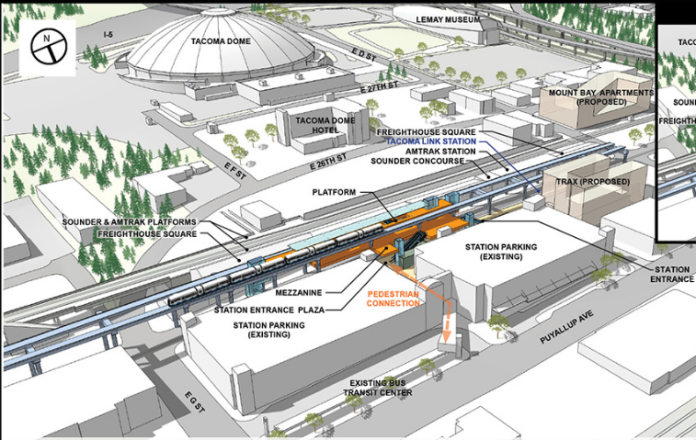The Link light rail extension from Federal Way to Tacoma Dome has entered the environmental review process with several segment alternatives under consideration. As part of this, Sound Transit has released new conceptual station site plans and companion renderings this week for the four stations that would dot the 10-mile corridor. The agency has also shared additional information about its Operations and Maintenance Facility (OMF) South siting options. Comment on the station options and OMF siting options is open through December 6th and awaiting your feedback.
Building upon the Federal Way Link Extension slated to open in 2024, Tacoma Dome Link Extension is scheduled to open in 2030, assuming Initiative 976 is either rejected in court or state legislators backfill the cuts–which Sound Transit estimates is a $20 billion hit to its budget through 2041. (Editor’s note: You can give state legislators a little encouragement by using this handy letter-writing tool.)
Light rail trips from Tacoma Dome to SeaTac Airport would take 35 minutes. The extension would add between 27,000 and 37,000 daily riders to the light rail network, Sound Transit projects, and cost about $2 billion in 2014 dollars. Sound Transit plans to refer to the Tacoma to Seattle line as the Green Line, unless the recent announcement that it won’t use “Red Line” to refer to the Seattle to Lynnwood (and ultimately Everett) line, as originally planned, leads to a wider rebranding.
South Federal Way Station
Sound Transit is evaluating two possible station locations for the South Federal Way Station: one off of Enchanted Parkway just south of S 348th St–the preferred option–and another at hugging the west side of I-5 just where Enchanted Parkway crosses the interstate.

For the station location at Enchanted Parkway and S 352nd St, Sound Transit would situate the guideway and an elevated platform just west of Enchanted Parkway. This could come in two flavors with either the platform fully located north of S 352nd St or straddling the street on both sides. Under both scenarios, a bus loop with bays and layover space, would be located just west of the platform. Buses would be able to access the site from a driveway access off of Enchanted Parkway and underneath the elevated guideway.
Parking could be constructed in a garage or as surface spaces, accommodating up to 500 vehicles. The garage option would put the parking west of the station platform and bus loop whereas the surface parking would be spread out to the west and north across a larger site footprint. This area of Federal Way is already a sea of parking, but it could conceivably become a transit-oriented district once light rail arrives, making structured parking and a smaller station footprint ideal.

Additionally, Sound Transit has identified possible plaza and pedestrian areas at the station as well as a kiss-and-ride location. Access to the platforms would include stairs, escalators, and elevators at either end for ease of access.
To visualize these conceptual layout, renderings of how the elevated guideway would pass through the area and profile of the station elements have been produced for the two options:

At the alternative station location next to I-5, the station would be set between S 356th St and Enchanted Parkway. Bus access would be via S 356th St and come with a loop for passenger loading and bus layover space. A kiss-and-ride area would also be near it with a network of plaza space woven throughout the site.

Similar to the other South Federal Way Station concept, the I-5 location could either include structured or surface parking for 500 stalls. The surface parking option would would essentially require twice the amount of space to satisfy the parking and station needs.

The station would have elevated platforms since the alignment would need to cross local roads in the area, including Enchanted Parkway. Access to the platforms would be by stairs, escalators, and elevators.
Fife Station
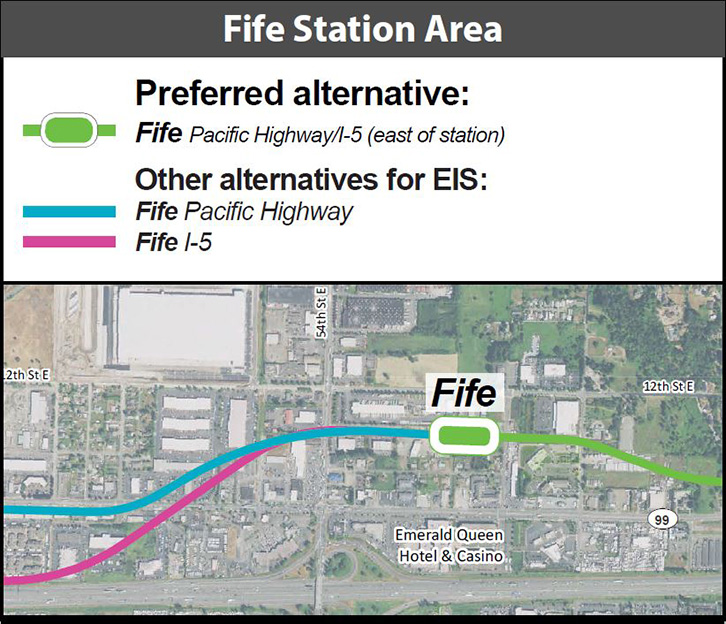
The next stop on the extension is the Fife Station. While there are two alternative segment options from the station to Tacoma, only one station location is being evaluated. The chosen location will roughly be west of 59th Ave E and between 12th St E and 15th St E. Access to the site is anticipated to be from both 59th Ave E and 12th St E.

The station will include an elevated platform and guideway with the platform west of 59th Ave E. Bus loading is expected to mostly occur on 59th Ave E, but it is possible that this could occur within the kiss-and-ride area, too. Sound Transit is also considering both surface-only and structured parking options for the station, which would accommodate up to 500 parking stalls.

Contextually, the area is largely industrial with some commercial and Emerald Queen Casino. But, the promise of light rail could spur transit-oriented development in an area otherwise constrained by critical areas, farmland, and tribal land.
Portland Avenue Station
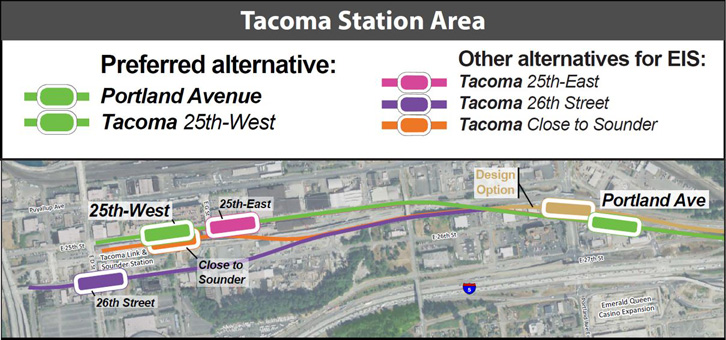
The first of two stations in Tacoma, the Portland Avenue Station could end up either squarely east of Portland Ave E or straddling it. Sound Transit is evaluating two design options, but the conceptual location for the station east Portland Ave E and south E 26th St is the primary option. Both options would involve construction of an elevated station and guideway.

If the primary option is chosen, the site would encompass most of the block bounded by the local streets and involve construction of an internal road network for kiss-and-ride functions. A bus loading and layover area would be located just north of the station on E 26th St and E Bay St. Sound Transit is also considering two bridge options to cross I-5 to reach the Puyallup Tribe reservation.

The alternative design option would place the station across both sides of Portland Avenue E. The benefit of this is that there would be easier pedestrian to the station throughout the area since stairs, escalators, and elevators would be on both sides of the street. Pedestrian access is particularly challenging in the area since the streets are built to prioritize car movements and freight. The pedestrian bridge options would still apply to the alternative design option and bus loading would be located on either side of Portland Ave E, making connections to light rail relatively easy. Similarly, the kiss-and-ride facilities would be split up for ease of access.
Though subtle in its design, the alternative design option also boasts a smaller long-term footprint, including the location of guideway, making it less disruptive to the development pattern around it and maximizing future infill potential and placemaking opportunities. Functionally, it could be a cheaper and better ridership option even if more complicated to engineer and construct.
Tacoma Dome Station

Finally, the last station on the extension will be at or near Tacoma Dome Station. Sound Transit is evaluated not one, not two, not three, but four station location options. The preferred option is on E 25th St adjacent to Tacoma Dome Station (Sounder and Link), known as the TD 25th West Alternative.

The TD 25th West Alternative would involve construction of an elevated platform next to the existing station parking garage on its south side. A mezzanine from the platform would lead to the plaza on the north side of E 25th St and the parking garage. Access to the platform and mezzanine would be via stairs, escalators, and elevators.

How the integration functionally would work is best shown in the rendering above. As a design option to this TD 25th West Alternative, Sound Transit is also considering moving the bus loading over westward away from the garages. This could reduce some of the walking distance to light rail, commuter rail, and streetcar and involve much less elevation changes, a particular advantage to those who with mobility challenges.
The TD 25th East Alternative would place the station east of E G St on E 25th St. It would similarly involve the construction of a mezzanine level. However, passengers would be conveyed to both sides of E 25th St and new plaza spaces would be added. Sound Transit is also evaluating a new kiss-and-ride area that would be located north of the station.


The functional disadvantage of the option is that it would spread out connections to bus, streetcar, and commuter rail options. Other negatives is that it would place the station two blocks closer to Portland Ave E, two blocks further from downtown and the Tacoma Dome, and require acquisition of a productive commercial use. Ultimately, there is a real threat that it would be more expensive long-term and reduce potential ridership.
The TD 26th Alternative would place the station on E 26th St straddling both sides of East D St with an elevated platform. This option would be the closest of the bunch to the Tacoma Dome. It would also only be a half-block south of Tacoma Dome Station, where Sounder commuter rail and Amtrak Cascades (soon to operate from) are housed. The streetcar, primary bus loop, and parking garage, however, are a further walk from the conceptual location. But like the other options, it would involve construction of a mezzanine and allow pedestrian access to both sides of E 26th St, though only east of D St.


To improve access to the other transit functions, Sound Transit is evaluating a possible pedestrian bridge from the station that would cross over the existing railroad tracks to the Sounder and Amtrak station.
While the TD 26th Alternative does not require a whole lot of real estate, it does seem to be an odd choice, given how divorced it would be from the other transit functions. Ideally, the option will be put to rest through the environmental review process, along with its cousin in the TD 25th East Alternative.
The final Tacoma Dome Station option is the TD Close to Sounder Option. This would involve demolishing much of Freighthouse Square, a historic icon for the neighborhood. Only the existing interior station and western portion of Freighthouse Square would be retained. The elevated platform would be located at the eastern end of where Freighthouse Square now stands while the tail tracks would fly over the retained building portions.


Underneath the platform and guideway, Sound Transit could construct a new building in place of the removed Freighthouse Square portions. This would facilitate a variety of station functions and some of the space could possibly be used for non-transit purposes, such as retail and restaurant uses. Though this may be a bit out-of-the-box thinking as far as station concepts go for Sound Transit, it is bound to rustle a lot of feathers over a historic structure that has already been the subject of extraordinary contention.
The owner of Freighthouse Square fought the state in its effort to acquire space for the new Amtrak facilitates, refusing to sell for a fair market value price. Ultimately, the owner settled allowing that project to move forward in 2016. But in that case, the historic integrity of the building was retained. Sound Transit’s proposal would dramatically undo that integrity despite no need to do so, given the readily available right-of-way to the building’s north and for little added passenger benefit.
Operations and Maintenance Facility South

As light rail grows, Sound Transit will need to accommodate more space for storage and maintenance of its light rail vehicles, which is why the OMF South is a key part of the Tacoma Dome Link Extension. The transit agency is planning to build a facility either in Federal Way or Kent, which could open in 2026. Through the initial selection process, six sites were trimmed down to three candidate locations, including at: Midway Landfill, S 336th St, and S 344th St.
Whatever site is chosen, Sound Transit reports that it will need to be able to facilitate storage and maintenance of at least 144 light rail vehicles. This will also require space for other equipment, a circle track around the facility, 100,000-square-foot maintenance building, 28,000-square-foot warehouse, and supportive facilities (e.g., stormwater facilities, utilities, landscaping, and parking).
The most northerly site under consideration is the Midway Landfill location, which is just south of Dick’s Drive-In that went to war with the transit agency to avoid consideration as a site. The is just west of I-5 and east of SR-99 between the blocks of S 246th St and S 252nd St. As the name suggests, it served as a former landfill and has all manner of problems due to hazardous wastes, flammable materials, and inevitable settling of refuse.
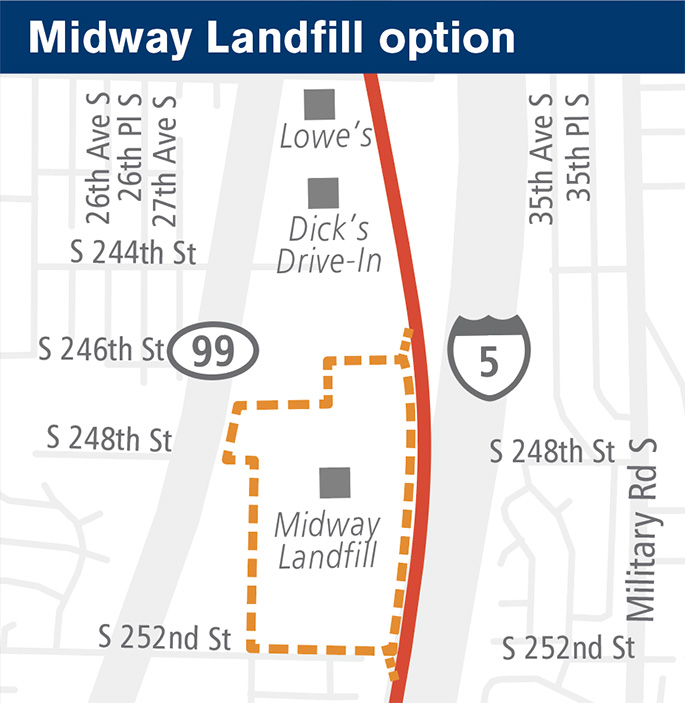
Though it is being considered as a site, the Midway Landfill site probably will not make the final cut since. Digging foundations and running heavy equipment atop the sealed landfill is a geotechnical nightmare, virtually assuring its future prospectives are limited to only urban parkland.
The locations under consideration in Federal Way are far more promising, but are predicated on construction of the Tacoma Dome Link Extension. Trains could arrive beforehand and be tested on the closed loop while the extension is underway but incomplete, but to move trains out of whatever site is chosen will require at least the first segment between Federal Way Transit Center and South Federal Way Station being complete.
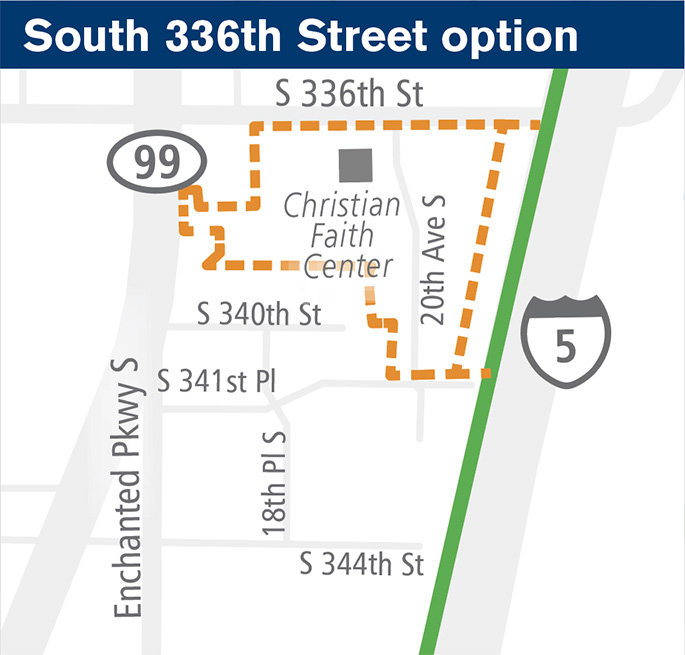
The S 336th St option would be located on property largely owned by the Christian Faith Center, a megachurch, as well as a small sliver of industrial land. A good chunk of land at the edges of the site is encumbered by environmentally critical areas, but overall the properties seem to fit the bill for a successful site.
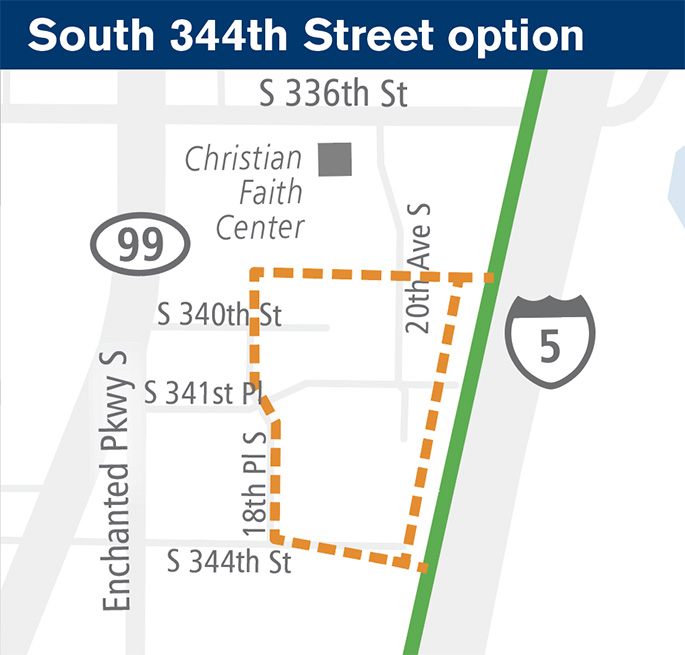
Overlapping, but a few blocks further south, Sound Transit is also considering a site between S 344th St and S 339th St. It would essentially abut I-5 and run as far west as 18th Pl S, on a five-block-by-three-block site. While this would largely avoid the Christian Faith Center property and environmentally critical areas, it would mean acquisition and displacement of many industrial and warehousing businesses and residents, an expensive and disruptive proposition.
Next Steps
The Draft Environmental Impact Statement (DEIS) for the Tacoma Dome Link Extension is expected to be issued in 2021 and the Final Environmental Impact Statement (FEIS) will follow in 2022, years ahead of construction. The corridor could open by 2030, again barring any calamities from the fallout of Tim Eyman’s anti-transit Initiative 976 that passed this month.
Meanwhile, a DEIS for OMF South is due for issuance late next year followed by the FEIS issuance in 2021. Comment on the station options and OMF siting options is open to public feedback through December 6th and Sound Transit will be holding a variety of drop-in sessions between now and then, which can be found online.
Stephen is a professional urban planner in Puget Sound with a passion for sustainable, livable, and diverse cities. He is especially interested in how policies, regulations, and programs can promote positive outcomes for communities. With stints in great cities like Bellingham and Cork, Stephen currently lives in Seattle. He primarily covers land use and transportation issues and has been with The Urbanist since 2014.

